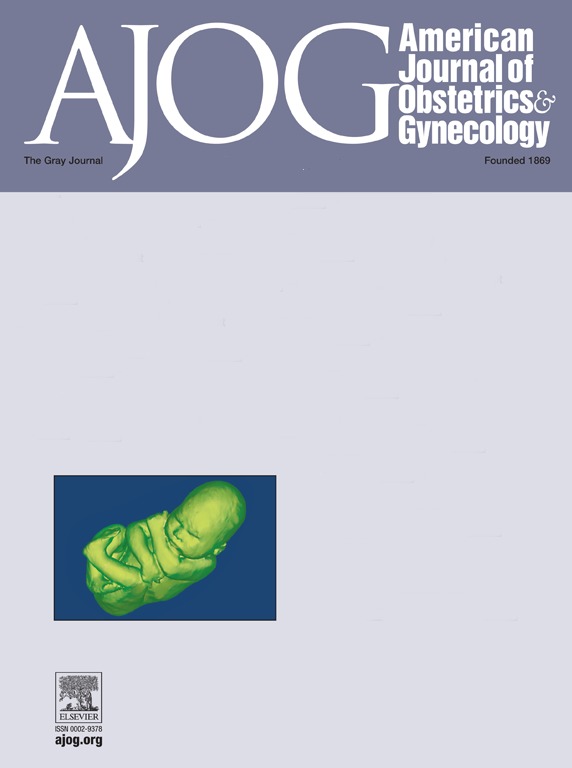Postnatal healing of cesarean scar: an ultrasound study.
IF 8.4
1区 医学
Q1 OBSTETRICS & GYNECOLOGY
引用次数: 0
Abstract
BACKGROUND Impaired healing of cesarean delivery scars results in long-term complications, including scar niche formation, which may adversely impact future pregnancies and lead to gynaecological symptoms such as postmenstrual spotting, dysmenorrhea and chronic pelvic pain. Moreover, there is increasing evidence that a cesarean delivery scar located close to or within the cervix is associated with an increased risk of subsequent spontaneous preterm birth. The factors influencing cesarean birth scar location and healing remain poorly understood. OBJECTIVE(S) We explored the impact of antenatal, intrapartum, intraoperative and postnatal factors on cesarean scar sonographic healing, location and morphology after cesarean delivery in labor. STUDY DESIGN This prospective observational cohort study recruited women who underwent cesarean delivery during active labor (cervical dilation 4-10 cm) at University College London Hospital, UK (January 2021-October 2022). Transvaginal ultrasound was performed 4 to 12 months postpartum to evaluate cesarean delivery scar characteristics and location relative to the internal cervical os. Indicators of impaired scar healing were presence of a scar niche (depth ≥2mm) and/or a healing ratio (residual/adjacent myometrial or cervical thickness) of ≤0.5. Regression analysis assessed the associations between clinical variables and cesarean scar parameters. RESULTS Cesarean delivery scars were identified in 96.8% of women recruited (90/93). Advanced labor cesarean delivery (8-10 cm dilatation) was associated with an eight-fold increased likelihood of a scar located at or caudal to the internal os (RR 7.77; 95% CI 2.59, 23.39; p<0.001) compared to cesarean birth performed earlier in labor (4-7 cm dilatation). Cervical dilatation and fetal station at surgery significantly influenced scar position relative to the internal cervical os (p<0.001). For each 1cm increase in cervical dilatation during labor, the scar was positioned 0.88mm more caudally on the uterus or cervix (95%CI 0.62, 1.14; p<0.001). Similarly, for each 1cm descent of the fetal part within the maternal pelvis, the cesarean scar was located 1.5mm more caudally on the uterus or cervix (95%CI 0.71, 2.33; p<0.001). The niche prevalence was 37.8% (34/90), of which 67.6% (23/24) had a healing ratio ≤0.5. Risk factors for suboptimal scar healing included BMI ≥ 25, increased uterine artery vascular Doppler resistance, gestational age > 40 weeks, the use of locking sutures during surgery and cesarean delivery scar location caudal to the internal os on postnatal ultrasound (p<0.05). Uterine scars, situated cranial to the internal os, had significantly larger niche dimensions compared to those located within the cervix, at or caudal to the internal os (p<0.05). CONCLUSION(S) Advanced cervical dilatation and low fetal station at emergency cesarean delivery in labor are independent predictors of cesarean scar location near or within the cervix, and these cervical scars heal less well than scars located higher in the uterus. Even women having a cesarean birth at 8-9cm have a high risk of the scar being close or within the cervix, which is known to increase the risk of subsequent spontaneous preterm birth. Further research is needed into the impact of cesarean scar characteristics on gynaecologic symptoms and future pregnancy outcomes and to develop techniques to improve cesarean scar healing.剖宫产瘢痕产后愈合的超声研究。
剖宫产疤痕的愈合受损会导致长期并发症,包括疤痕生态位的形成,这可能对未来的怀孕产生不利影响,并导致月经后出血、痛经和慢性盆腔疼痛等妇科症状。此外,越来越多的证据表明,宫颈附近或宫颈内的剖宫产疤痕与随后自发性早产的风险增加有关。影响剖宫产疤痕位置和愈合的因素仍然知之甚少。目的:探讨产前、产时、术中及产后因素对剖宫产术后瘢痕超声愈合、定位及形态的影响。研究设计:这项前瞻性观察队列研究招募了在英国伦敦大学学院医院(University College London Hospital)(2021年1月至2022年10月)进行主动分娩(宫颈扩张4-10厘米)剖宫产的妇女。术后4 ~ 12个月行阴道超声检查剖宫产瘢痕特征及相对于宫颈内腔的位置。疤痕愈合受损的指标是存在疤痕生态位(深度≥2mm)和/或愈合比(残余/邻近肌层或宫颈厚度)≤0.5。回归分析评估临床变量与剖宫产疤痕参数之间的关系。结果96.8%(90/93)的受访女性存在剖宫产疤痕。晚期产程剖宫产(扩张8-10 cm)与8倍的可能性增加有关,瘢痕位于内骶髂关节尾部(RR 7.77; 95% CI 2.59, 23.39; p 40周,手术中使用锁定缝合线和剖宫产时瘢痕位于内骶髂关节尾部(p<0.05)。子宫瘢痕位于子宫内os的颅侧,其生态位尺寸明显大于位于子宫颈、子宫内os的尾端或尾端(p<0.05)。结论(5)急诊剖宫产时宫颈提前扩张和低胎位是宫颈附近或宫颈内剖宫产瘢痕发生的独立预测因素,且宫颈瘢痕愈合较子宫高位瘢痕差。即使是在8-9厘米剖腹产的妇女,疤痕靠近或在子宫颈内的风险也很高,这已知会增加随后自然早产的风险。需要进一步研究剖宫产疤痕特征对妇科症状和未来妊娠结局的影响,并开发改善剖宫产疤痕愈合的技术。
本文章由计算机程序翻译,如有差异,请以英文原文为准。
求助全文
约1分钟内获得全文
求助全文
来源期刊
CiteScore
15.90
自引率
7.10%
发文量
2237
审稿时长
47 days
期刊介绍:
The American Journal of Obstetrics and Gynecology, known as "The Gray Journal," covers the entire spectrum of Obstetrics and Gynecology. It aims to publish original research (clinical and translational), reviews, opinions, video clips, podcasts, and interviews that contribute to understanding health and disease and have the potential to impact the practice of women's healthcare.
Focus Areas:
Diagnosis, Treatment, Prediction, and Prevention: The journal focuses on research related to the diagnosis, treatment, prediction, and prevention of obstetrical and gynecological disorders.
Biology of Reproduction: AJOG publishes work on the biology of reproduction, including studies on reproductive physiology and mechanisms of obstetrical and gynecological diseases.
Content Types:
Original Research: Clinical and translational research articles.
Reviews: Comprehensive reviews providing insights into various aspects of obstetrics and gynecology.
Opinions: Perspectives and opinions on important topics in the field.
Multimedia Content: Video clips, podcasts, and interviews.
Peer Review Process:
All submissions undergo a rigorous peer review process to ensure quality and relevance to the field of obstetrics and gynecology.

 求助内容:
求助内容: 应助结果提醒方式:
应助结果提醒方式:


